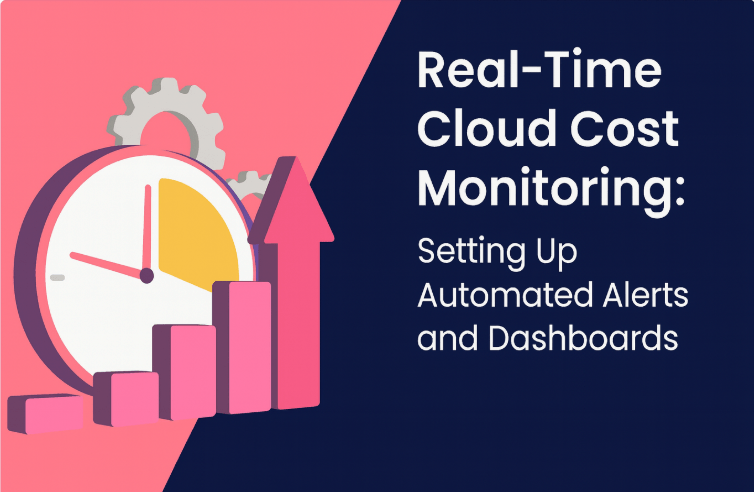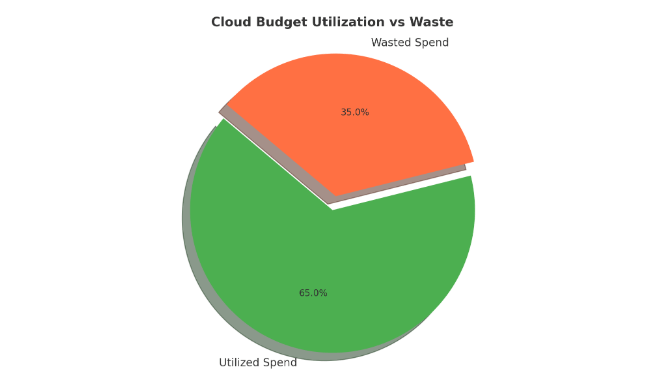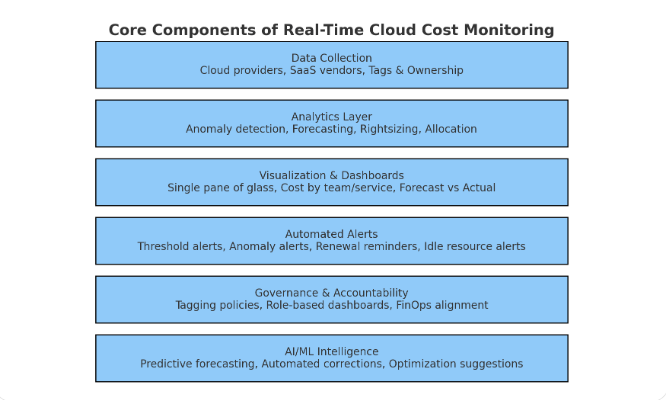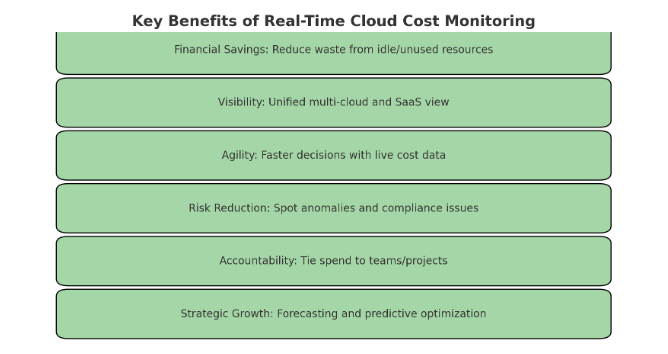
In today’s digital-first economy, businesses run on cloud infrastructure and SaaS applications. While the scalability of the cloud is its greatest strength, it also creates a double-edged sword: uncontrolled costs. Without proper monitoring, organizations often face budget overruns, underutilized resources, and even financial risks. That is why real-time cloud cost monitoring has emerged as a critical practice.
Automated alerts and dashboards provide visibility, accountability, and proactive management of cloud spending. Instead of reacting to unexpected billing shocks at the end of the month, enterprises can track costs live, take corrective actions immediately, and forecast more accurately.
This article explores how to design and implement real-time monitoring systems, integrate automated alerts, and build dashboards that drive smarter decision-making. It also highlights how solutions like Binadox empower businesses to manage cloud and SaaS costs effectively with automation, integrations, and actionable insights.
Why Real-Time Cloud Cost Monitoring Matters
The Financial Impact of Cloud Waste
The rapid adoption of cloud and SaaS platforms has transformed IT operations, but it has also created a hidden challenge: uncontrolled spending. Gartner estimates that companies waste 30–40% of their cloud budgets due to underutilized or forgotten resources. This includes idle VMs, abandoned storage, and SaaS licenses that are no longer in use but still billed every month.
These inefficiencies are not minor oversights—they can accumulate into millions of dollars in unnecessary annual expenses for enterprises operating at scale. By deploying real-time monitoring, businesses can detect this waste immediately and take corrective measures before it snowballs into significant financial loss.
Cost Visibility Across Multi-Cloud and SaaS Ecosystems
Most organizations now operate in a hybrid or multi-cloud environment, often with 50–100 SaaS applications in parallel. Without a unified monitoring system, costs are scattered across billing portals, currencies, and regions. This lack of transparency leaves financial teams struggling to reconcile budgets and IT leaders blind to actual consumption.
Real-time monitoring platforms like Binadox provide a single pane of glass to track both cloud and SaaS costs. By consolidating expenses across AWS, Azure, GCP, and SaaS vendors, they ensure that finance, IT, and DevOps teams share the same source of truth.
Business Agility and Risk Reduction
Beyond cost savings, live monitoring enhances business agility. Finance leaders gain the ability to forecast with precision, operations teams can scale resources without fearing budget overruns, and executives can allocate capital more effectively.
It also plays a critical role in risk management. Cost anomalies may signal misconfigurations, fraudulent activity, or even security breaches. For example, a sudden spike in API calls or storage usage could indicate unauthorized access. Real-time alerts make it possible to respond to such issues instantly, mitigating both financial and compliance risks.
Driving a Culture of Accountability
When departments and teams see their cost data in real-time dashboards, accountability naturally increases. Business units can no longer ignore the financial impact of their workloads because usage is visible, trackable, and tied directly to their budgets. This creates a FinOps culture, where finance and IT collaborate seamlessly to optimize both performance and cost.
Long-Term Strategic Benefits
Ultimately, real-time cost monitoring is not just about avoiding overspending today—it’s about ensuring long-term sustainability. With predictive analytics and machine learning being integrated into monitoring platforms, businesses can forecast demand, rightsize proactively, and negotiate better vendor contracts. This transforms monitoring from a reactive tool into a strategic enabler of growth.

Core Components of Real-Time Cloud Cost Monitoring
A successful real-time monitoring framework rests on three interdependent layers: data collection, analytics, and visualization with automated alerts. When designed together, they create a closed-loop system that not only monitors but also optimizes spend.
1. Data Collection: Building the Foundation
The first step is comprehensive data ingestion. Modern organizations pull data from multiple sources:
- Cloud providers (AWS, Azure, GCP, DigitalOcean) supply usage metrics, pricing details, and billing reports.
- SaaS vendors (Office 365, Salesforce, Zoom, Slack, etc.) provide license utilization and subscription invoices.
- Internal tagging systems assign ownership by project, region, department, or environment.
Without structured data collection, monitoring is fragmented and incomplete. Platforms like Binadox automate this step by integrating with dozens of cloud vendors and SaaS apps. They also normalize multi-currency invoices into a single reporting standard, which is critical for global enterprises.
2. Analytics Layer: Turning Raw Data into Insights
Once collected, raw data must be processed into actionable intelligence. This is where analytics adds value by:
- Detecting anomalies: Identifying sudden spikes in storage or compute usage that deviate from normal baselines.
- Trend analysis: Comparing historical spend with forecasted usage to spot seasonal patterns.
- Rightsizing recommendations: Suggesting adjustments for over-provisioned VMs or underutilized SaaS licenses.
- Allocation modeling: Assigning costs to business units, customers, or projects for more accurate financial reporting.
Binadox, for example, includes a Cost Explorer tool to detect spikes and a Rightsizing module that provides instance-level optimization recommendations. These tools allow IT and finance teams to shift from reactive cost reporting to proactive cost prevention.
3. Visualization and Dashboards: Cost Transparency in Action
Dashboards are the single pane of glass that unify cloud and SaaS data for all stakeholders. A well-designed dashboard delivers clarity across multiple dimensions:
- Spend by provider (AWS, Azure, GCP, etc.)
- Spend by category (compute, storage, network)
- Spend by business unit/team/project
- Idle vs. utilized resources
- Forecast vs. actual spend
In practice, dashboards must be interactive, real-time, and customizable. For example, Binadox’s Cloud Utilization Dashboard allows filtering by tags, comparing accounts, and drilling into anomalies. The SaaS Utilization Dashboard complements this by showing license adoption, renewal dates, and potential savings opportunities.
4. Automated Alerts: From Awareness to Action
While dashboards provide visibility, alerts ensure timely action. Real-time notifications are essential for preventing runaway costs and compliance breaches. Alerts should include:
- Budget threshold alerts – triggered when daily or monthly spend exceeds a set limit.
- Anomaly alerts – based on AI/ML detection of unusual cost spikes.
- Idle resource alerts – notifying when instances run idle for extended periods.
- Renewal alerts – warning before SaaS subscription renewals to avoid surprise expenses.
Binadox enhances this with Automation Rules, where alerts can also trigger corrective actions. For example, an idle resource alert can automatically stop an EC2 instance, or a SaaS renewal alert can deactivate unused licenses.
5. Governance and Accountability Layer
An often overlooked but critical component is governance. Monitoring without governance leads to finger-pointing rather than optimization. Best practices include:
- Mandatory tagging policies to ensure resources are attributed correctly.
- Role-based dashboards so executives see summaries while engineers access granular details.
- FinOps alignment to promote collaboration between finance and IT.
This layer ensures that the monitoring system not only tracks costs but also drives organizational accountability and cultural adoption.
6. Continuous Improvement with AI/ML
The final piece is intelligence. Machine learning models can:
- Predict budget overruns weeks before they happen.
- Recommend the most cost-effective pricing models (spot, reserved, savings plans).
- Automatically fix tagging errors.
- Highlight underutilized SaaS apps for retirement.
This transforms real-time monitoring into a predictive and prescriptive practice, evolving from reactive control into a strategic advantage.

Steps to Implement Real-Time Cost Monitoring
1. Establish Governance and Ownership
Start with clear accountability:
- Finance owns budget limits.
- IT/DevOps owns optimization.
- Business units own SaaS subscriptions.
Tagging cloud resources by team, environment, or project ensures costs are correctly allocated.
2. Integrate Multi-Cloud and SaaS Sources
Modern enterprises run hybrid and multi-cloud environments. Manual tracking is ineffective, so integration is key:
- AWS Cost Explorer, Azure Cost Management, Google Billing for raw data.
- SaaS applications like Zoom, Salesforce, Office 365 for subscription visibility.
Platforms like Binadox integrate all providers into a unified view.
3. Build Custom Dashboards
Use KPIs tailored to your business goals:
- Cost per customer
- Cost per environment (production vs. staging)
- Cost per team/region
Dashboards should be real-time, interactive, and customizable, with filters by service, account, or tag.
4. Configure Automated Alerts
Set alerts based on both absolute numbers and usage patterns:
- Example: “Notify me if daily AWS spend exceeds $1,000.”
- Example: “Alert if EC2 instance runs idle for 24 hours.”
5. Automate Actions
Beyond alerts, automation reduces manual effort. Rules can:
- Stop underutilized instances.
- Rightsize workloads.
- Deactivate inactive SaaS licenses.
This creates a closed-loop system where monitoring directly drives optimization.
Dashboards in Action: Key Use Cases
Case 1: SaaS License Management
A global company with 100+ SaaS apps faced 20% waste due to unused licenses. By using Binadox’s License Manager and Renewals Calendar, they gained real-time alerts before renewals, saving thousands monthly.
Case 2: Cloud Anomaly Detection
A fintech firm noticed sudden cost spikes in GCP. With anomaly alerts and a cost explorer, the root cause (a misconfigured API service) was resolved within hours instead of after the monthly bill.
Case 3: Multi-Currency Consolidation
A multinational enterprise operating in USD, EUR, and GBP used Binadox to aggregate costs across currencies, standardize reporting, and avoid hidden conversion losses.
Future of Real-Time Cost Monitoring
The next evolution lies in AI and machine learning-driven automation. Instead of static thresholds, ML models will:
- Predict departmental usage
- Auto-correct tagging errors
- Forecast budget overruns weeks in advance
- Recommend optimal pricing models (spot vs. reserved instances)

We also see integration with edge computing and vertical-specific SaaS solutions, where cost visibility will extend to distributed workloads and industry-tailored platforms.
How Binadox Enables Real-Time Cloud Cost Monitoring
Binadox combines multi-cloud visibility, SaaS management, and automation:
- Unified dashboards for SaaS and cloud costs
- Custom anomaly detection and cost explorer
- Rightsizing recommendations for cloud workloads
- Renewals calendar for SaaS licenses
- Automation rules for proactive optimization
It allows organizations to save up to 30% on cloud and SaaS spending while maintaining compliance and operational efficiency.
Conclusion
Real-time cloud cost monitoring with automated alerts and dashboards is no longer optional—it is essential. As organizations scale across multi-cloud and SaaS ecosystems, financial risks from waste and inefficiency grow exponentially.
By adopting integrated platforms like Binadox, enterprises can ensure real-time visibility, proactive anomaly detection, and automated cost optimization. The result is not just cost savings, but also greater agility, accountability, and financial resilience in a rapidly evolving digital landscape.

